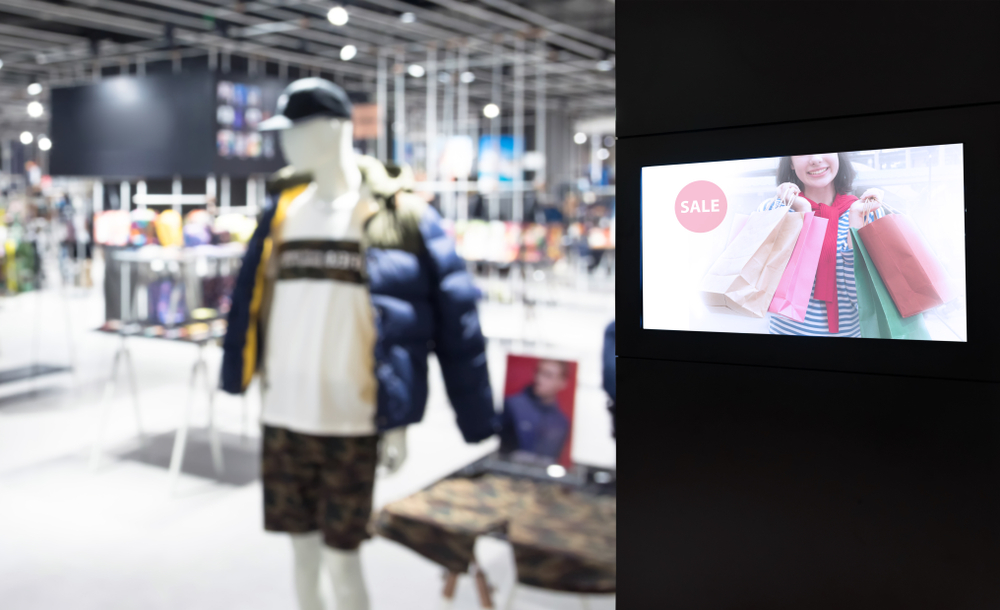The benefits of digital signage in retail are numerous and can have a significant positive impact on your ROI. Read on to discover how retail digital signage can transform the in-store experience and the key considerations you should make.
Digital signage is undoubtedly most visible in the retail industry. However, despite being early adopters in 1980, retail stores have changed dramatically since then. While stores are getting smaller, product ranges are getting larger.
Displaying more products in a smaller place is a significant challenge for retailers. That’s where digital signage comes in.
With the rise of new technology the digital signage industry is moving in a whole new direction, with more focus on content creation and intelligent software to make content distribution easier.
At Databeat, we have summarised the benefits of digital signage in retail below, along with the key questions you should consider to support your marketing strategy.
Attract customers with enticing displays
Digital signage can encourage customers to spend up to 30% more time browsing. But it's great for in-and-out sales too, guiding shoppers to their desired product.
Key questions to consider:
What is your current audience and what future audience do you want to attract?
You can use existing data, knowledge, and experience to create digital signage that supports your current customers’ purchasing decisions. Incorporating the answers to their frequently asked questions on digital screens is a great place to start.
When it comes to attracting your future target audience, consider their wants, needs, and pain points. Sharing a consistent message across all stores will help to build trust in your brand, increasing the likelihood of them converting to a paying customer.
Why do you want customers to stop and spend more time in certain zones in store?
When introducing digital signs, it’s important to know what type of value they will bring your customers when stopping at that particular zone. This could be to share discounts or highlight an exclusive new product and its features.
It’s essential to make sure your content is tailored to support that particular area in addition to your customers’ needs. For example, if you have a demo area for a product, consider strategically-placed content to support customers’ purchasing decisions.
Discover how David-Andersen uses digital signage to enhance the in-store customer experience.
Promote offers to increase sales
Studies show digital signage for retail can increase sales by 29.5%. In fact, one in five consumers make unplanned purchases after seeing visual triggers in store.
Key question to consider:
How do customers move in store and which areas do they spend the most time in?
Mapping customers’ movements inside your store can help you identify where digital signs would be beneficial. Defining spaces that customers usually stop and seek information will ultimately allow you to create content that helps customers buy.
For example, you could create dynamic, engaging content for entrance, point of sale, service, and information areas to pique customers’ interest and encourage them to convert.
Boost brand awareness
Digital signage provides endless opportunities to help retailers promote their brand. Will it be your brand or someone else's that people see?
Key questions to consider:
What type of in-store customer experience do you want to create?
“Courteous treatment will make a customer a walking advertisement.”
— James Cash Penney
Although the above quote is from a long time ago, it’s still just as relevant (if not more so) today.
Using digital signage is a powerful way to improve the in-store customer experience. Retail digital signage can be used to:
- Promote offers and display price information
- Highlight the benefits of using your products/services
- Provide information on key product features and functionalities
Overlooking the benefits of digital signage in retail stores is a missed opportunity to create an unrivaled customer experience and ultimately turn your customers into a walking advertisement for your brand.
What objectives do you want digital signage to accomplish in your store?
Everything starts with a motive. What are your objectives? Do you have a need for advertising in store? Do you want to use digital signage for informational purposes only?
Once you have determined your reasons for using in-store digital signage, creating a plan and sticking to it will be key to your store’s success.
Discover why GANT switched from printed posters to digital signage in its stores.
Digital signage objectives to inspire your content
Measuring the success of your digital signage can be a challenge. That’s why we recommend setting clear objectives from the start to not only help you evaluate ROI, but to understand the impact your digital signage has on customers.
Here are a few ideas of objectives to get you started:
- To instruct your viewers or customers
- To inspire
- To simplify in-store processes
- Generate more sales
- To inform customers
- Turn waiting lines into valuable upsale opportunities
- Help make purchasing decisions
- Attract customers to the store
- Strengthen brand awareness
- Create a great customer experience
- Modernise the in-store experience
Finally, we recommend asking customers for as much feedback as possible — preferably in the form of a survey. The more feedback you receive, the more data you have to assess how well you’re meeting your business objectives.
To learn more about how you can use in-store digital signage to improve ROI, click the button below to download our free guide.








.png)